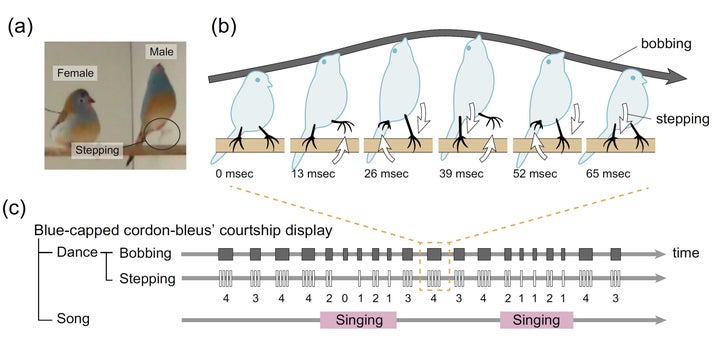Want to see some impressive tap dancing? Just watch songbirds woo each other.
An international team of researchers recently captured incredible slow-motion footage of the blue-capped cordon bleu's courtship behavior. The clip above shows two birds bobbing and singing -- which scientists have long known they do -- and reveals a dance that hasn't been seen before, National Geographic reported.
"We thought that we found a secret, as we had been puzzled by the fact that only cordon-blues (but not other Estrildid finches) made conspicuous sounds when hopping," said Dr. Masayo Soma, a co-author of the research published last month in Scientific Reports and an associate professor at Hokkaido University in Japan.
Soma and her colleagues used a high-speed camera to analyze the courtship displays of 16 blue-capped cordon bleu songbirds. They discovered that both male and female birds appear to "tap dance," and that their dancing increases in speed when a bird they're trying to mate with is perched nearby. The motions are so fast that they can't be seen by the naked human eye.
The researchers concluded that the tap dancing may add attractive sounds to the birds' courtship displays, or possibly send secret signals to another bird.
"Usually in songbirds, complex acoustic features were preferred as sexual signals. So, cordon-blues may add sounds using their feet," Soma said. "Another idea is that signals that can be conveyed by multiple modalities are efficient. Tap dancing can serve as auditory, visual or tactile signal."

The researchers noted that more studies are needed to better understand how the singing, bobbing and dancing behaviors are all coordinated.
"We still do not know why only cordon bleus show tap dancing and other related birds do not perform it," Soma said. "It is even more surprising that both males and females possess the same behavioral features, given that generally males are more ornamented and show more exaggerated sexual displays."
Dr. Will Allen, a behavioral ecologist at the University of Hull in England who was not involved in the research, told BBC News the newly discovered tap dancing is a "very cool behavior" but that he was keen to see it explored in more detail.
"We already know that several non-passerine birds perform similar elaborate, multimodal duets and that many passerines duet in song," he said.
"What's new here is that there's a passerine species -- a songbird -- that is duetting in both song and dance," he added. "This study is an important first step, but we don't know whether the receiver prefers mates that display these dancing movements, or even that the receiver is sensitive to them. There are some suggestions here that they might, but without an experimental-type design, we can't work that out."
Also on HuffPost:

